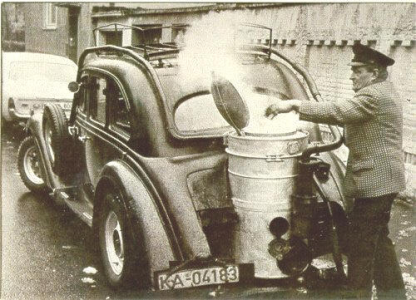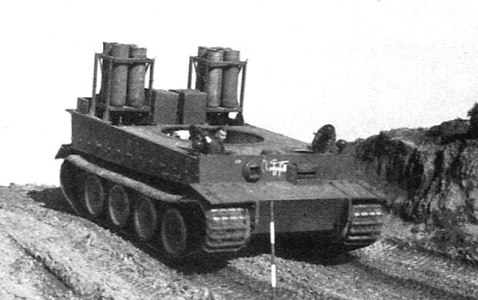-
Welcome back Guest! Did you know you can mentor other members here at H-M? If not, please check out our Relaunch of Hobby Machinist Mentoring Program!
You are using an out of date browser. It may not display this or other websites correctly.
You should upgrade or use an alternative browser.
You should upgrade or use an alternative browser.
Gasifiers
- Thread starter Chewy
- Start date
- Joined
- Feb 13, 2017
- Messages
- 2,138
Carbon monoxide (CO) is flammable. It is called by many names like "Producer Gas" but is just CO. A gasoline engine needs nominally to be started on gasoline. But will run at around 65% capacity on CO. A fire will produce CO2 until it reaches a high temperature, I read I think 1300F. Not sure but it sounds reasonable. The fuel can be anything that burns well. Firewood is the first choice on the subject, but coal, biomass, pellets(wood), dry grass, hay, dung, ad infinitum, ad nauseum. Basicly anything that will run a steam engine.
There are countless texts and videos on the web. I have a couple, three books on the subject that predate the web as we know it today. The bookseller (time has lost his name) had a number of books on the subject. He is no longer in business but some books can be found at other esoteric booksellers. I am terribly sorry, I'm old and have lost a good portion of my memory. The subject is widely known, CO has been used as a fuel even in recent days.
The trick is to collect the CO once the fire is hot enough, cool it, and send to a carburator. You won't be able to run 120 MPH, more like 40. But you can run. . . Doing a search for "producer Gas Plants" yielded endless pages of links, some useful, some not so, and some just gimmicks.
.
There are countless texts and videos on the web. I have a couple, three books on the subject that predate the web as we know it today. The bookseller (time has lost his name) had a number of books on the subject. He is no longer in business but some books can be found at other esoteric booksellers. I am terribly sorry, I'm old and have lost a good portion of my memory. The subject is widely known, CO has been used as a fuel even in recent days.
The trick is to collect the CO once the fire is hot enough, cool it, and send to a carburator. You won't be able to run 120 MPH, more like 40. But you can run. . . Doing a search for "producer Gas Plants" yielded endless pages of links, some useful, some not so, and some just gimmicks.
.
Thanks! I found this fascinating. One of the things that amazed me is that with all the stuff I read and studied about the WW's, This is the first time I saw so much of this gasification in use. France practically relied on it to fight in the wars. I am going to look and see if there are any plans that might make a good model.
- Joined
- Feb 13, 2017
- Messages
- 2,138
I would hope a working model, which would actually be a miniature version. There was a YouTube video of a fellow that built a small plant to run a gen-set. A small generator, less than 2 KW, a portable rig that was moved with a hand truck. Sorry, I didn't save the link, I was already aware of the points he made. But worth searching for as a novice. . .
One of my books on the subject is:
-Producer Gas for Motor Vehicles-
John D & Martin G Cash
Original Pub Angus & Robertson Sydney 1942
Reprint Lindsay Publications, Inc Bradley, Ill 1997
ISBN 1-55918-187-7 (Reprint)
Lindsay had a veritable s#!tload of books on esoteric, obsolete, and little known technology, reprints of his own publishing in softback form. He has gone out of business c.2010, retired, deceased, I don't know. Some of the books were Dover publishing, the technical side. Lindsay and Dover seemed to work hand in hand on many titles, in both directions. Lindsay books are/were available through several booksellers on the web. Mostly "new old stock", my memories are long past. They would need to be searched for today.
.
One of my books on the subject is:
-Producer Gas for Motor Vehicles-
John D & Martin G Cash
Original Pub Angus & Robertson Sydney 1942
Reprint Lindsay Publications, Inc Bradley, Ill 1997
ISBN 1-55918-187-7 (Reprint)
Lindsay had a veritable s#!tload of books on esoteric, obsolete, and little known technology, reprints of his own publishing in softback form. He has gone out of business c.2010, retired, deceased, I don't know. Some of the books were Dover publishing, the technical side. Lindsay and Dover seemed to work hand in hand on many titles, in both directions. Lindsay books are/were available through several booksellers on the web. Mostly "new old stock", my memories are long past. They would need to be searched for today.
.
- Joined
- Dec 18, 2019
- Messages
- 6,539
And of course, a reminder, carbon monoxide is poisonous. I was told my great grandfather died from a CO leak at his bakery. Way back then they used CO as a fuel. From Wikipedia: Carbon monoxide primarily causes adverse effects by combining with hemoglobin to form carboxyhemoglobin (HbCO) preventing the blood from carrying oxygen and expelling carbon dioxide as carbaminohemoglobin.[5]
Doesn't take much concentration to disrupt your body. Be careful if you go this route. End of public service announcement. Sorry for the disruption.
Doesn't take much concentration to disrupt your body. Be careful if you go this route. End of public service announcement. Sorry for the disruption.
- Joined
- Jul 28, 2017
- Messages
- 2,403
Carbon monoxide also can combine with some metals to form volatile (and highly toxic) gasses. The Mond process reacts carbon monoxide with impure nickel to form nickel carbonyl. It is carried off, leaving the impurities behind, and reduced back to metallic nickel in a separate step. Some carbonyls can be accidentally formed when the conditions are just right. According to Wikipedia, iron carbonyl can be made at room temperature if you start with very pure, finely-divided iron powder, but you have to work much harder at it if you want to do something similar to the nickel Mond process on an industrial scale.
So-called "water gas" was made by passing steam through a heated bed of coal. It is a mixture of hydrogen and carbon monoxide (and likely a bit of CO2). Piped into turn of the century homes for light and heat, I think that stuff was the origin of the "put your head in the oven" method of committing suicide. It also killed a number of people who didn't want to go just yet.
And of course we hear about people being killed by electric generators every time there's an extended power outage.
So-called "water gas" was made by passing steam through a heated bed of coal. It is a mixture of hydrogen and carbon monoxide (and likely a bit of CO2). Piped into turn of the century homes for light and heat, I think that stuff was the origin of the "put your head in the oven" method of committing suicide. It also killed a number of people who didn't want to go just yet.
And of course we hear about people being killed by electric generators every time there's an extended power outage.
- Joined
- Dec 18, 2019
- Messages
- 6,539
Yes, water gas is what killed my great grandfather. Lots of CO in it. As far as I know, water gas is no longer being used for non industrial heating. Natural gas has replaced it.
- Joined
- Nov 14, 2016
- Messages
- 3,022
Gassification and bio-oil are very interesting tech. In 2010 I did a paper for the final of a forestry class I was taking. My topic was disposal methods of woody material. Gassification featured prominently as it can provide fuel for electrical production, and related products are bio-oil and charcoal both of which can be used for a variety of uses including as fuels. Bio-oil is very similar to heating oil and can be refined like a heavy petroleum oil into lighter fuels like gasoline or diesel.
The tech goes back to prehistoric times. A very basic process was used in South America to create charcoal used to improve the soils for food production. The gasses and oils produced were burned off leaving just the charcoal. The Egyptians used a similar process to create a "tar" that they used to seal hulls of their boats. "Coal or Wood" gas was was used to power gas lights in the late 1800s. During WW2 millions of vehicles had on board gassifiers installed allowing them to run on wood instead of gasoline.

The Germans even experimented with using it to power tanks although I don't believe they actually fielded any. They did use it to power military trucks though later in the war when they had major fuel shortages.

There are a number of companies selling gassifier powered generators, and bio-oil convertors. When used to make bio-oil the process is started with propane, and then once started the "wood gas" is burned in place of the propane to maintain the process. Bio-oil and charcoal are left which can be used for a variety of uses.
It is not very complicated and you can find lots of examples of DIY projects converting generators and vehicles to gassifiers or making home bio-oil / charcoal producers.
Here is an Instructables for making a gassifier powered generator.
Using wood to fuel a generator
The tech goes back to prehistoric times. A very basic process was used in South America to create charcoal used to improve the soils for food production. The gasses and oils produced were burned off leaving just the charcoal. The Egyptians used a similar process to create a "tar" that they used to seal hulls of their boats. "Coal or Wood" gas was was used to power gas lights in the late 1800s. During WW2 millions of vehicles had on board gassifiers installed allowing them to run on wood instead of gasoline.

The Germans even experimented with using it to power tanks although I don't believe they actually fielded any. They did use it to power military trucks though later in the war when they had major fuel shortages.

There are a number of companies selling gassifier powered generators, and bio-oil convertors. When used to make bio-oil the process is started with propane, and then once started the "wood gas" is burned in place of the propane to maintain the process. Bio-oil and charcoal are left which can be used for a variety of uses.
It is not very complicated and you can find lots of examples of DIY projects converting generators and vehicles to gassifiers or making home bio-oil / charcoal producers.
Here is an Instructables for making a gassifier powered generator.
Using wood to fuel a generator

